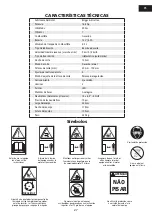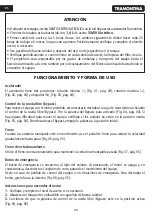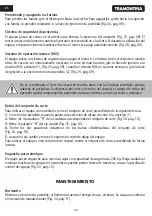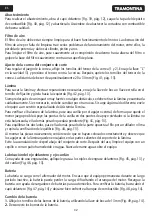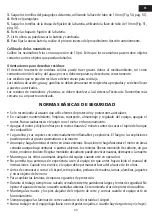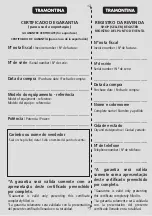
21
EN
Turning the lights on and off
Turn on the lights by turning the switch clockwise. Turn them off by turning it anticlockwise. Lights only
work with the ignition turned on [Fig. 26, page 09].
Presence safety system
The equipment comes with a seat sensor that detects the presence of an operator [Fig. 27, page 09].
The engine only starts if the operator is sitting on the seat. If the operator tries to get up from the seat
while using the equipment, the engine automatically shuts down [Fig. 28, page 09].
Reverse operation system (ROS)
The equipment comes with a safety system that shuts down the engine if attempts are made to cut the
grass in reverse. If it is really necessary to cut the grass in reverse, turn the ignition key to the ROS on
position (1), [Fig. 29, page 09]. When the ROS system is no longer needed, turn the ignition key to the
engine on position (2), [Fig. 29, page 09].
Cutting grass in reverse with the blades connected is not recommended, for in addition to
affecting cutting and grass-discharge efficiency, operator vision is compromised, causing
possible accidents to other people or animals.
Removing the cutter assembly
To use the equipment as a utility vehicle, remove the cutter assembly as follows:
1.
With the engine off, move the cutter-assembly height selection lever to position (1).
2.
Remove the 4 “R” pins from the chains holding the cutter assembly [Fig. 30, page 10].
3.
Remove the “R” pin from the cardan drive [Fig. 31, page 10].
4.
Remove the front pins from the cutter-assembly stabiliser bars [Fig. 32, page 10].
5.
Lift the cardan drive and remove the cutter assembly from the equipment.
To use the equipment as a lawn mower, reverse the steps to replace the cutter assembly.
Towing hitch
The equipment has a towing hitch for trailers with maximum capacity of 200 kg. Take care when towing
heavy loads on slopes, as the tires may slip and cause loss of control of the equipment [Fig. 33, page 10].
MAINTENANCE
Engine hour meter
When the motor is on the meter indicates running time in hours. It is used to control maintenance intervals
[Fig. 34, page 11].





















